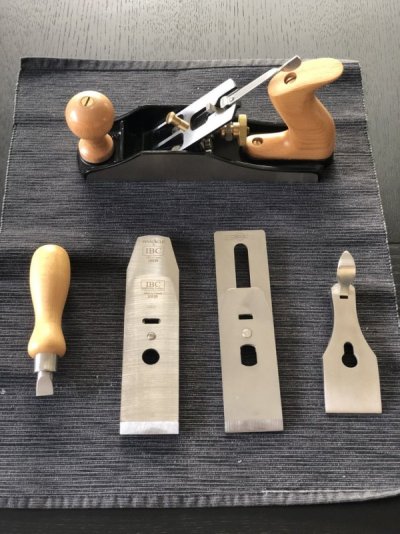Wat is het verschil tussen de twee beitels?
De IBC beitel is wat dikker en gemaakt van A2 staal , of zoals de beschrijving zo mooi geeft "high vanadium A-2 steel, 0.140” thick, 60-62HRc and cryogenically treated to optimize the cutting edge’s wear resistance". Samen met een exact passende keerbeitel (genummerde set, beetje marketing maar toch ook wel merkbaar).
De Hock beitel is van O1 staal en wat dunner (0.094"). Erg fijne beitel ook die makkelijk te slijpen is en net nog wat scherper te krijgen is dan A2 maar de A2 variant heeft een langere standtijd.
Een vergelijking die ik in het boek van Hock tegenkwam;
O1 vs. A2
For our “high carbon” steel blades, HOCK TOOLS uses AISI (American Iron and Steel Institute) O1, a simple high carbon tool steel with very little added to the iron/steel alloy other than 1.1% manganese. That pinch of Mn allows the steel to harden with an oil quench (the “O” in O1 stands for Oil.) Oil removes heat more slowly than water, reducing the thermal shock that occurs when orange-hot steel is plunged into water. Reducing that thermal shock minimizes the risk of cracking or distortion in the hardened piece. With an alloy as simple as O1, containing so few alloying elements, the hardened grain structure is as fine as possible which allows honing to the sharpest possible edge.
AISI A2 differs from O1 with the addition of 5% chromium and 1.1% molybdenum, allowing it to quench in still air (“A” for Air.) While “stainless” amounts of chromium (12% or more) make tool steel “gummy” and hard to sharpen, the modest amount of chromium in A2 improves its toughness and abrasion resistance, but imparts only a slight measure of corrosion resistance (like high carbon steel, it will rust and appropriate preventative care must be taken.) But there is a trade off. During heat treatment the chromium addition combines with some of the carbon in the alloy to form chromium carbides – tough, hard particles dispersed through the steel. These carbides are the primary contributors to A2’s celebrated edge retention. However, during heat treatment, the chromium carbides can grow quite large – large enough to affect your ability to hone the edge as close to zero-radius as you may want. And these carbides are held in place with less strength than the rest of the steel matrix which can allow them to pop out under the stress of honing or cutting leaving a small gap in the edge. To strengthen the edge we recommend a larger bevel angle for A2 than we would use for O1. For a bench plane iron, try your A2 blade at about 30° or 33°. A chisel or block plane blade can be even steeper; try 35° or so and see if edge retention is improved.
A2 is one of the steels that respond well to cryogenic treatment. This extreme cold treatment (-320°F) essentially finishes the original quench, increasing the steel’s toughness without any decrease in hardness. You get increased wear resistance without any increase in brittleness so a cryogenically treated blade will hold its edge longer. You can keep working instead of sharpening. A2 is a great steel that offers a real improvement in edge retention. O1, on the other hand, is still preferred by many for its relative ease of sharpening and its ability to get sharper.
In de praktijk gewoon alletwee prima beitels, soms werkt de één net wat beter op lastiger hout dan de ander. Maar de verschillen zijn subtiel en ook een beetje persoonlijke voorkeur. Vond het ook altijd wel prettig 2 scherpe beitels te hebben als ik een stukje af te werken had.


